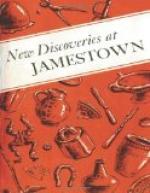[Illustration: An assortment of glass bottle seals in the Jamestown collection. Some of the wealthy planters had their initials (or other ornamental device) stamped on the shoulders of the wine bottles which they ordered from England.]
[Illustration: This Dutch gin bottle excavated at Jamestown was imported from Holland.]
About 1650 the practice of affixing glass seals or buttons on the shoulders of English wine bottles was begun. The seal was inscribed with a name, or initials, or a date; sometimes a coat of arms or a crest, or other device or ornament. Many of these glass bottle seals have been found at Jamestown. As a rule, only the wealthy and influential planters had seals stamped on their wine bottles.
Gin bottles found at Jamestown are tall and square with thin glass sides. Imported from Holland, many were made as early as 1625. One gin bottle was miraculously unearthed intact, and not as much as a chip or crack was found on this 300-year-old fragile specimen.
FOOD STORAGE VESSELS AND FACILITIES
Many earthenware jars, pots, bowls, and jugs excavated at Jamestown were used for the storage of foods. Wooden and wicker containers were also used, although because of their perishable nature none was unearthed. Seventeenth-century inventories list many of these perishable storage items, including casks, barrels, hogsheads, tubs, bins, and baskets. Leather bottles are also mentioned in a few early records.
[Illustration: Earthenware vessels used for the storage of foods. Some were made at Jamestown, some were imported from England.]
[Illustration: “Harvesting” Ice, about 1650. Archeological excavations revealed that ICEHOUSES were built on the historic island over 300 years ago. (Painting by Sidney E. King.)]
A brick-lined storage compartment was found in the cellar (below floor level) of one of the 17th-century buildings. It was used, undoubtedly, for the storage of such easily spoiled foods as milk, cheese, eggs, and cream. Wine, too, was probably kept in bottles in the cool compartment, as many broken bottles were found inside.
An extremely important discovery was a large, deep, ice-storage pit, believed to be the only 17th-century ice pit which has been excavated in Virginia. The conjectural painting on page 48 shows its probable appearance when in use about 1650. Ice-storage pits held dairy products, meats, and other spoilable foods as well as ice. Pond ice was usually cut and stored in the pit in late winter. Sometimes it lasted until late summer or early autumn.




